Types of Audit Opinions and their Justification
VerifiedAdded on 2022/12/29
|5
|1582
|36
AI Summary
This document discusses three independent situations and the type of audit opinion that should be expressed in each situation. It also provides a link between internal control and substantive testing, and explains the advantages and disadvantages of the narrative approach to documenting a client's system of internal control.
Contribute Materials
Your contribution can guide someone’s learning journey. Share your
documents today.
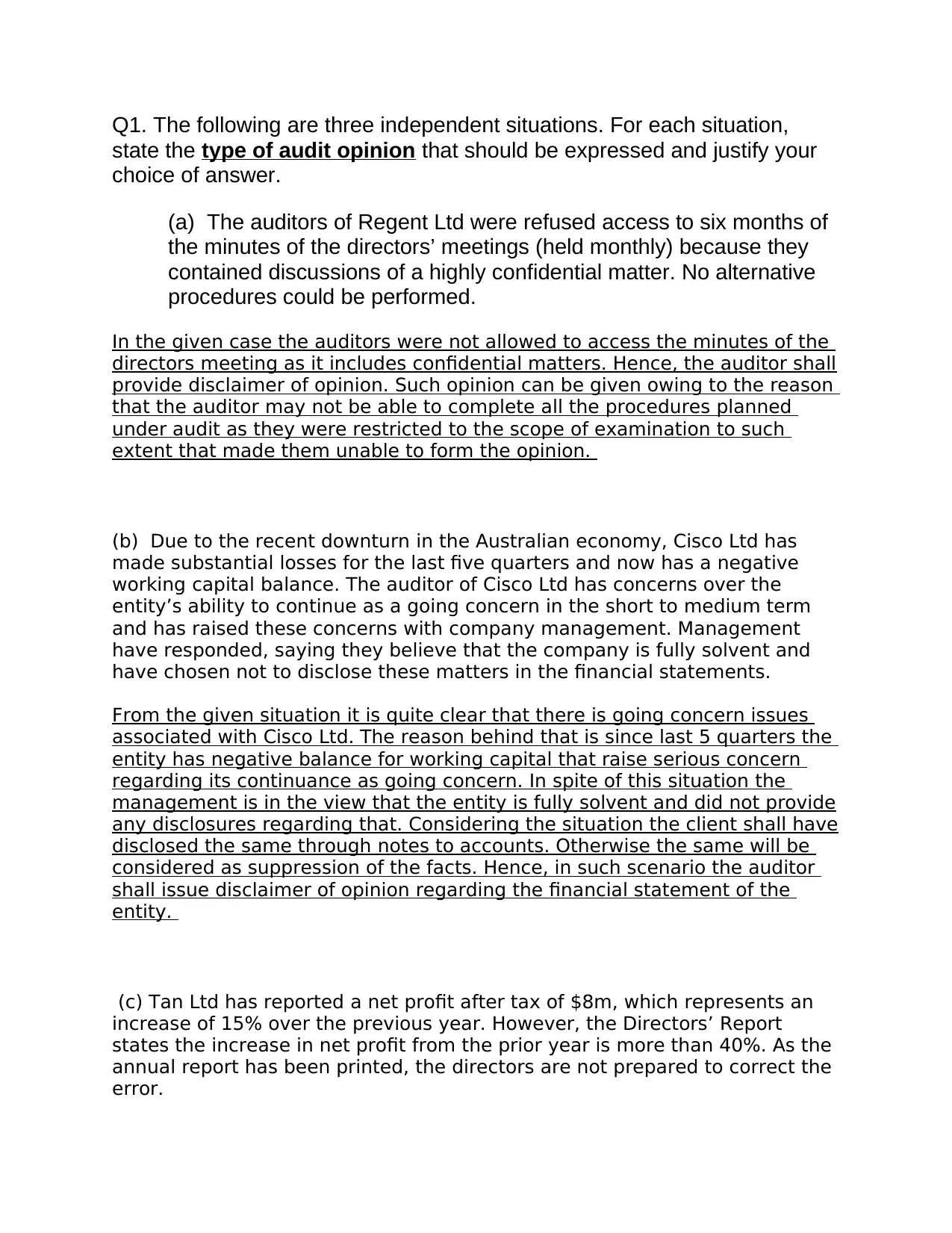
Q1. The following are three independent situations. For each situation,
state the type of audit opinion that should be expressed and justify your
choice of answer.
(a) The auditors of Regent Ltd were refused access to six months of
the minutes of the directors’ meetings (held monthly) because they
contained discussions of a highly confidential matter. No alternative
procedures could be performed.
In the given case the auditors were not allowed to access the minutes of the
directors meeting as it includes confidential matters. Hence, the auditor shall
provide disclaimer of opinion. Such opinion can be given owing to the reason
that the auditor may not be able to complete all the procedures planned
under audit as they were restricted to the scope of examination to such
extent that made them unable to form the opinion.
(b) Due to the recent downturn in the Australian economy, Cisco Ltd has
made substantial losses for the last five quarters and now has a negative
working capital balance. The auditor of Cisco Ltd has concerns over the
entity’s ability to continue as a going concern in the short to medium term
and has raised these concerns with company management. Management
have responded, saying they believe that the company is fully solvent and
have chosen not to disclose these matters in the financial statements.
From the given situation it is quite clear that there is going concern issues
associated with Cisco Ltd. The reason behind that is since last 5 quarters the
entity has negative balance for working capital that raise serious concern
regarding its continuance as going concern. In spite of this situation the
management is in the view that the entity is fully solvent and did not provide
any disclosures regarding that. Considering the situation the client shall have
disclosed the same through notes to accounts. Otherwise the same will be
considered as suppression of the facts. Hence, in such scenario the auditor
shall issue disclaimer of opinion regarding the financial statement of the
entity.
(c) Tan Ltd has reported a net profit after tax of $8m, which represents an
increase of 15% over the previous year. However, the Directors’ Report
states the increase in net profit from the prior year is more than 40%. As the
annual report has been printed, the directors are not prepared to correct the
error.
state the type of audit opinion that should be expressed and justify your
choice of answer.
(a) The auditors of Regent Ltd were refused access to six months of
the minutes of the directors’ meetings (held monthly) because they
contained discussions of a highly confidential matter. No alternative
procedures could be performed.
In the given case the auditors were not allowed to access the minutes of the
directors meeting as it includes confidential matters. Hence, the auditor shall
provide disclaimer of opinion. Such opinion can be given owing to the reason
that the auditor may not be able to complete all the procedures planned
under audit as they were restricted to the scope of examination to such
extent that made them unable to form the opinion.
(b) Due to the recent downturn in the Australian economy, Cisco Ltd has
made substantial losses for the last five quarters and now has a negative
working capital balance. The auditor of Cisco Ltd has concerns over the
entity’s ability to continue as a going concern in the short to medium term
and has raised these concerns with company management. Management
have responded, saying they believe that the company is fully solvent and
have chosen not to disclose these matters in the financial statements.
From the given situation it is quite clear that there is going concern issues
associated with Cisco Ltd. The reason behind that is since last 5 quarters the
entity has negative balance for working capital that raise serious concern
regarding its continuance as going concern. In spite of this situation the
management is in the view that the entity is fully solvent and did not provide
any disclosures regarding that. Considering the situation the client shall have
disclosed the same through notes to accounts. Otherwise the same will be
considered as suppression of the facts. Hence, in such scenario the auditor
shall issue disclaimer of opinion regarding the financial statement of the
entity.
(c) Tan Ltd has reported a net profit after tax of $8m, which represents an
increase of 15% over the previous year. However, the Directors’ Report
states the increase in net profit from the prior year is more than 40%. As the
annual report has been printed, the directors are not prepared to correct the
error.
Secure Best Marks with AI Grader
Need help grading? Try our AI Grader for instant feedback on your assignments.
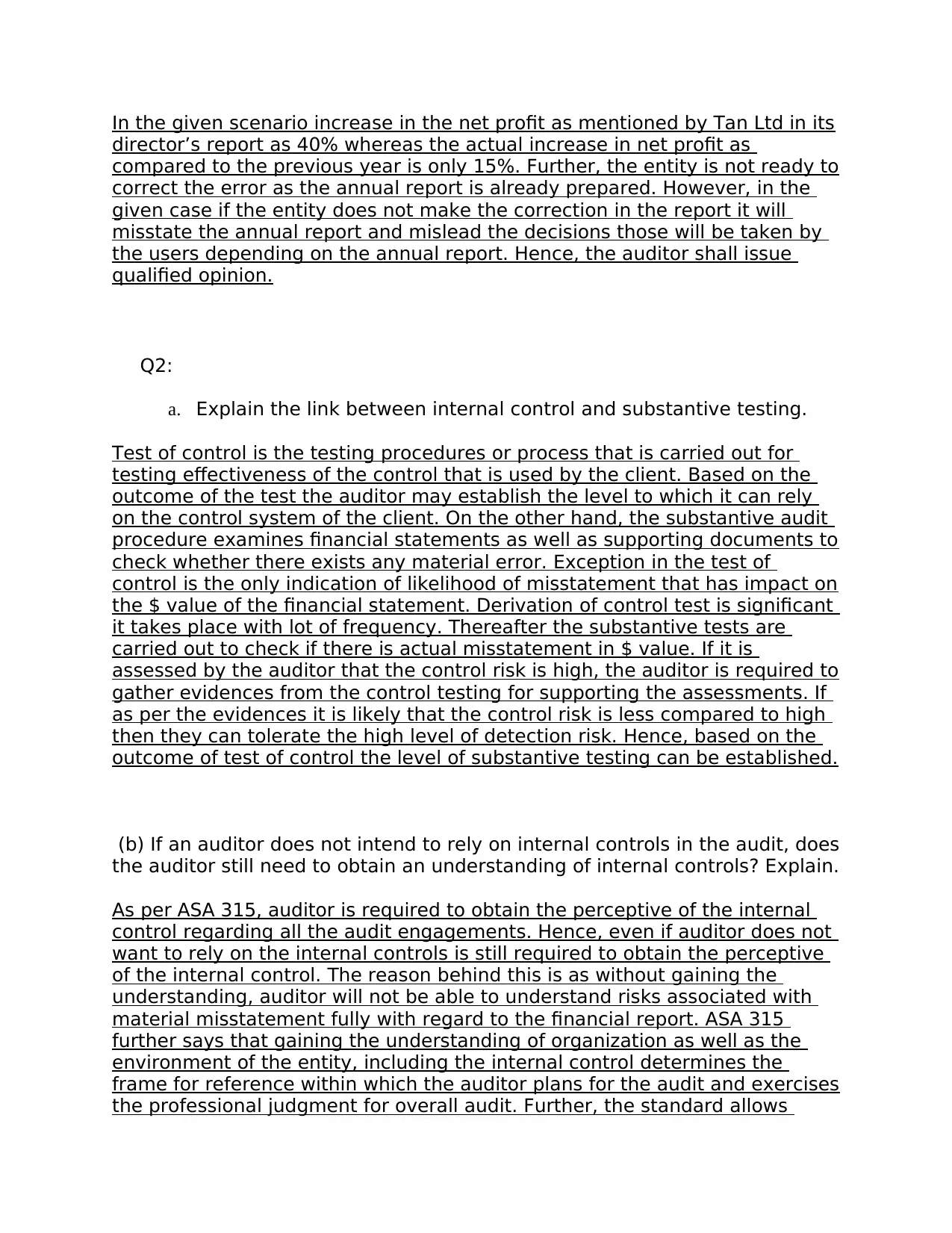
In the given scenario increase in the net profit as mentioned by Tan Ltd in its
director’s report as 40% whereas the actual increase in net profit as
compared to the previous year is only 15%. Further, the entity is not ready to
correct the error as the annual report is already prepared. However, in the
given case if the entity does not make the correction in the report it will
misstate the annual report and mislead the decisions those will be taken by
the users depending on the annual report. Hence, the auditor shall issue
qualified opinion.
Q2:
a. Explain the link between internal control and substantive testing.
Test of control is the testing procedures or process that is carried out for
testing effectiveness of the control that is used by the client. Based on the
outcome of the test the auditor may establish the level to which it can rely
on the control system of the client. On the other hand, the substantive audit
procedure examines financial statements as well as supporting documents to
check whether there exists any material error. Exception in the test of
control is the only indication of likelihood of misstatement that has impact on
the $ value of the financial statement. Derivation of control test is significant
it takes place with lot of frequency. Thereafter the substantive tests are
carried out to check if there is actual misstatement in $ value. If it is
assessed by the auditor that the control risk is high, the auditor is required to
gather evidences from the control testing for supporting the assessments. If
as per the evidences it is likely that the control risk is less compared to high
then they can tolerate the high level of detection risk. Hence, based on the
outcome of test of control the level of substantive testing can be established.
(b) If an auditor does not intend to rely on internal controls in the audit, does
the auditor still need to obtain an understanding of internal controls? Explain.
As per ASA 315, auditor is required to obtain the perceptive of the internal
control regarding all the audit engagements. Hence, even if auditor does not
want to rely on the internal controls is still required to obtain the perceptive
of the internal control. The reason behind this is as without gaining the
understanding, auditor will not be able to understand risks associated with
material misstatement fully with regard to the financial report. ASA 315
further says that gaining the understanding of organization as well as the
environment of the entity, including the internal control determines the
frame for reference within which the auditor plans for the audit and exercises
the professional judgment for overall audit. Further, the standard allows
director’s report as 40% whereas the actual increase in net profit as
compared to the previous year is only 15%. Further, the entity is not ready to
correct the error as the annual report is already prepared. However, in the
given case if the entity does not make the correction in the report it will
misstate the annual report and mislead the decisions those will be taken by
the users depending on the annual report. Hence, the auditor shall issue
qualified opinion.
Q2:
a. Explain the link between internal control and substantive testing.
Test of control is the testing procedures or process that is carried out for
testing effectiveness of the control that is used by the client. Based on the
outcome of the test the auditor may establish the level to which it can rely
on the control system of the client. On the other hand, the substantive audit
procedure examines financial statements as well as supporting documents to
check whether there exists any material error. Exception in the test of
control is the only indication of likelihood of misstatement that has impact on
the $ value of the financial statement. Derivation of control test is significant
it takes place with lot of frequency. Thereafter the substantive tests are
carried out to check if there is actual misstatement in $ value. If it is
assessed by the auditor that the control risk is high, the auditor is required to
gather evidences from the control testing for supporting the assessments. If
as per the evidences it is likely that the control risk is less compared to high
then they can tolerate the high level of detection risk. Hence, based on the
outcome of test of control the level of substantive testing can be established.
(b) If an auditor does not intend to rely on internal controls in the audit, does
the auditor still need to obtain an understanding of internal controls? Explain.
As per ASA 315, auditor is required to obtain the perceptive of the internal
control regarding all the audit engagements. Hence, even if auditor does not
want to rely on the internal controls is still required to obtain the perceptive
of the internal control. The reason behind this is as without gaining the
understanding, auditor will not be able to understand risks associated with
material misstatement fully with regard to the financial report. ASA 315
further says that gaining the understanding of organization as well as the
environment of the entity, including the internal control determines the
frame for reference within which the auditor plans for the audit and exercises
the professional judgment for overall audit. Further, the standard allows
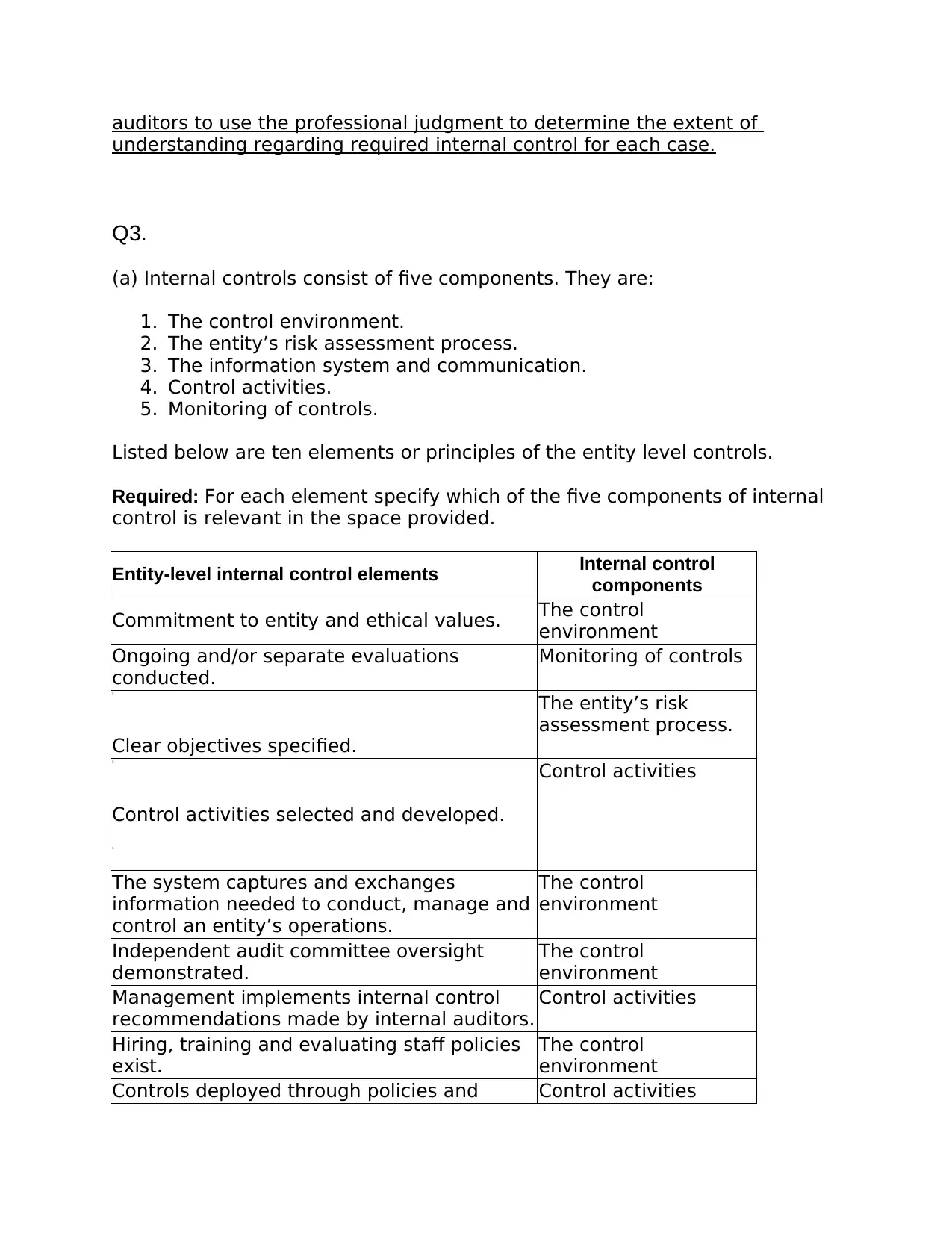
auditors to use the professional judgment to determine the extent of
understanding regarding required internal control for each case.
Q3.
(a) Internal controls consist of five components. They are:
1. The control environment.
2. The entity’s risk assessment process.
3. The information system and communication.
4. Control activities.
5. Monitoring of controls.
Listed below are ten elements or principles of the entity level controls.
Required: For each element specify which of the five components of internal
control is relevant in the space provided.
Entity-level internal control elements Internal control
components
Commitment to entity and ethical values. The control
environment
Ongoing and/or separate evaluations
conducted.
Monitoring of controls
Clear objectives specified.
The entity’s risk
assessment process.
Control activities selected and developed.
Control activities
The system captures and exchanges
information needed to conduct, manage and
control an entity’s operations.
The control
environment
Independent audit committee oversight
demonstrated.
The control
environment
Management implements internal control
recommendations made by internal auditors.
Control activities
Hiring, training and evaluating staff policies
exist.
The control
environment
Controls deployed through policies and Control activities
understanding regarding required internal control for each case.
Q3.
(a) Internal controls consist of five components. They are:
1. The control environment.
2. The entity’s risk assessment process.
3. The information system and communication.
4. Control activities.
5. Monitoring of controls.
Listed below are ten elements or principles of the entity level controls.
Required: For each element specify which of the five components of internal
control is relevant in the space provided.
Entity-level internal control elements Internal control
components
Commitment to entity and ethical values. The control
environment
Ongoing and/or separate evaluations
conducted.
Monitoring of controls
Clear objectives specified.
The entity’s risk
assessment process.
Control activities selected and developed.
Control activities
The system captures and exchanges
information needed to conduct, manage and
control an entity’s operations.
The control
environment
Independent audit committee oversight
demonstrated.
The control
environment
Management implements internal control
recommendations made by internal auditors.
Control activities
Hiring, training and evaluating staff policies
exist.
The control
environment
Controls deployed through policies and Control activities
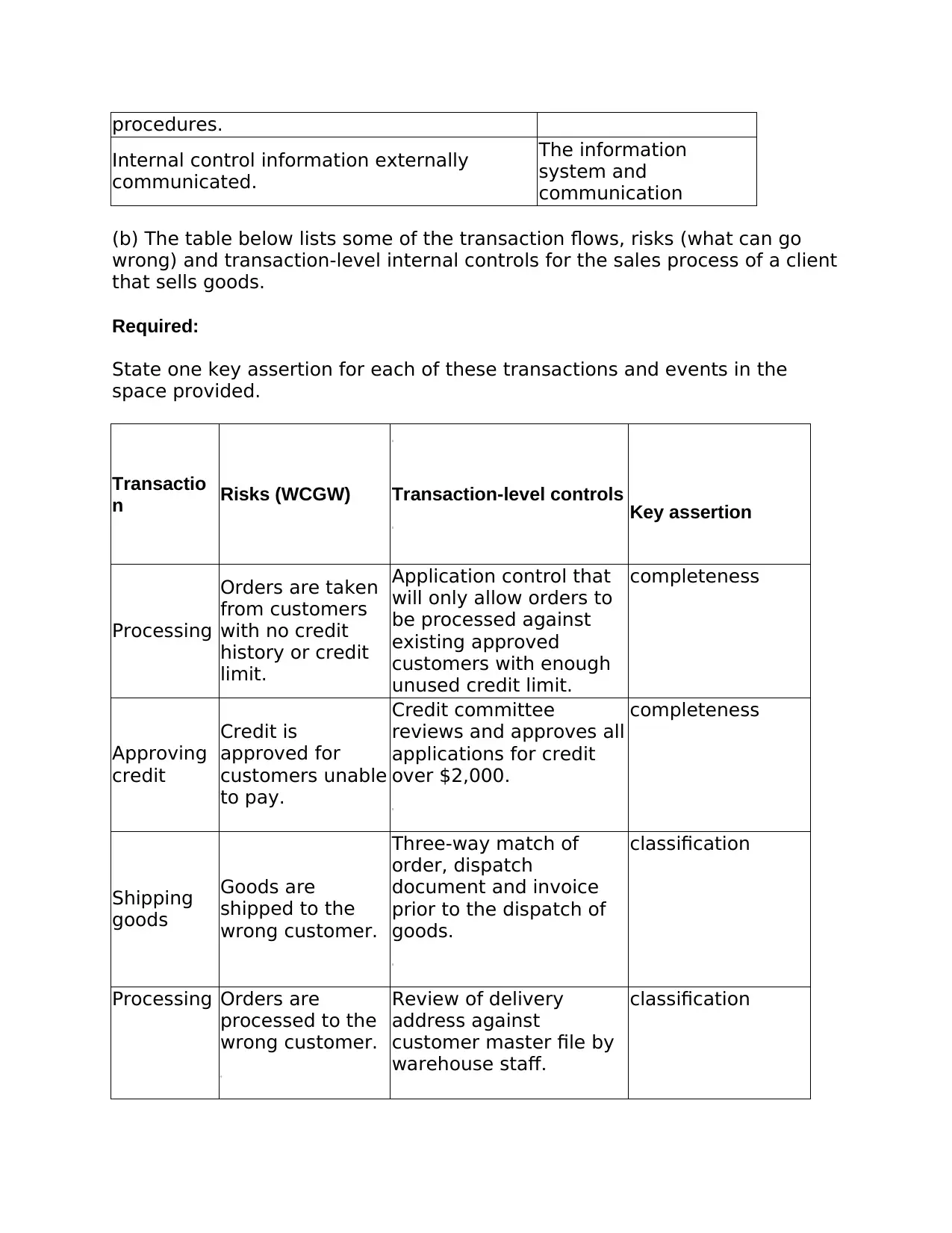
procedures.
Internal control information externally
communicated.
The information
system and
communication
(b) The table below lists some of the transaction flows, risks (what can go
wrong) and transaction-level internal controls for the sales process of a client
that sells goods.
Required:
State one key assertion for each of these transactions and events in the
space provided.
Transactio
n Risks (WCGW) Transaction-level controls Key assertion
Processing
Orders are taken
from customers
with no credit
history or credit
limit.
Application control that
will only allow orders to
be processed against
existing approved
customers with enough
unused credit limit.
completeness
Approving
credit
Credit is
approved for
customers unable
to pay.
Credit committee
reviews and approves all
applications for credit
over $2,000.
completeness
Shipping
goods
Goods are
shipped to the
wrong customer.
Three-way match of
order, dispatch
document and invoice
prior to the dispatch of
goods.
classification
Processing Orders are
processed to the
wrong customer.
Review of delivery
address against
customer master file by
warehouse staff.
classification
Internal control information externally
communicated.
The information
system and
communication
(b) The table below lists some of the transaction flows, risks (what can go
wrong) and transaction-level internal controls for the sales process of a client
that sells goods.
Required:
State one key assertion for each of these transactions and events in the
space provided.
Transactio
n Risks (WCGW) Transaction-level controls Key assertion
Processing
Orders are taken
from customers
with no credit
history or credit
limit.
Application control that
will only allow orders to
be processed against
existing approved
customers with enough
unused credit limit.
completeness
Approving
credit
Credit is
approved for
customers unable
to pay.
Credit committee
reviews and approves all
applications for credit
over $2,000.
completeness
Shipping
goods
Goods are
shipped to the
wrong customer.
Three-way match of
order, dispatch
document and invoice
prior to the dispatch of
goods.
classification
Processing Orders are
processed to the
wrong customer.
Review of delivery
address against
customer master file by
warehouse staff.
classification
Paraphrase This Document
Need a fresh take? Get an instant paraphrase of this document with our AI Paraphraser
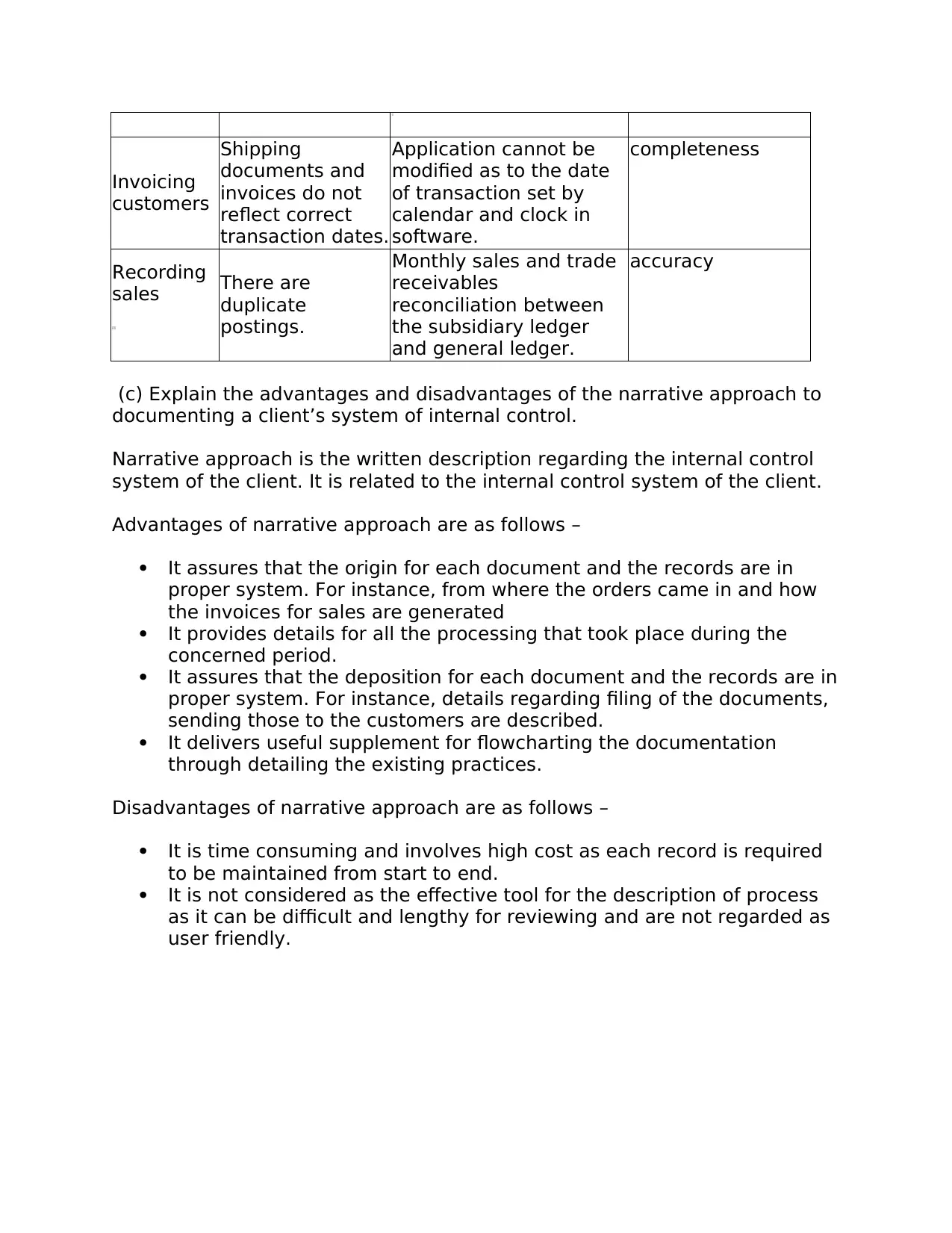
Invoicing
customers
Shipping
documents and
invoices do not
reflect correct
transaction dates.
Application cannot be
modified as to the date
of transaction set by
calendar and clock in
software.
completeness
Recording
sales There are
duplicate
postings.
Monthly sales and trade
receivables
reconciliation between
the subsidiary ledger
and general ledger.
accuracy
(c) Explain the advantages and disadvantages of the narrative approach to
documenting a client’s system of internal control.
Narrative approach is the written description regarding the internal control
system of the client. It is related to the internal control system of the client.
Advantages of narrative approach are as follows –
It assures that the origin for each document and the records are in
proper system. For instance, from where the orders came in and how
the invoices for sales are generated
It provides details for all the processing that took place during the
concerned period.
It assures that the deposition for each document and the records are in
proper system. For instance, details regarding filing of the documents,
sending those to the customers are described.
It delivers useful supplement for flowcharting the documentation
through detailing the existing practices.
Disadvantages of narrative approach are as follows –
It is time consuming and involves high cost as each record is required
to be maintained from start to end.
It is not considered as the effective tool for the description of process
as it can be difficult and lengthy for reviewing and are not regarded as
user friendly.
customers
Shipping
documents and
invoices do not
reflect correct
transaction dates.
Application cannot be
modified as to the date
of transaction set by
calendar and clock in
software.
completeness
Recording
sales There are
duplicate
postings.
Monthly sales and trade
receivables
reconciliation between
the subsidiary ledger
and general ledger.
accuracy
(c) Explain the advantages and disadvantages of the narrative approach to
documenting a client’s system of internal control.
Narrative approach is the written description regarding the internal control
system of the client. It is related to the internal control system of the client.
Advantages of narrative approach are as follows –
It assures that the origin for each document and the records are in
proper system. For instance, from where the orders came in and how
the invoices for sales are generated
It provides details for all the processing that took place during the
concerned period.
It assures that the deposition for each document and the records are in
proper system. For instance, details regarding filing of the documents,
sending those to the customers are described.
It delivers useful supplement for flowcharting the documentation
through detailing the existing practices.
Disadvantages of narrative approach are as follows –
It is time consuming and involves high cost as each record is required
to be maintained from start to end.
It is not considered as the effective tool for the description of process
as it can be difficult and lengthy for reviewing and are not regarded as
user friendly.
1 out of 5
![[object Object]](/_next/static/media/star-bottom.7253800d.svg)




